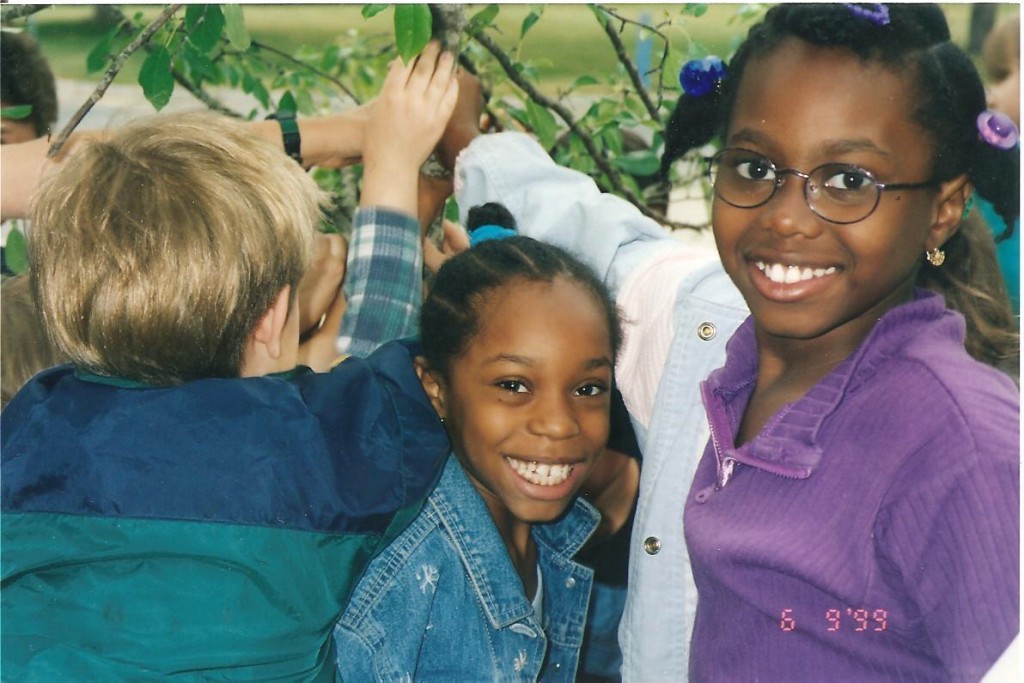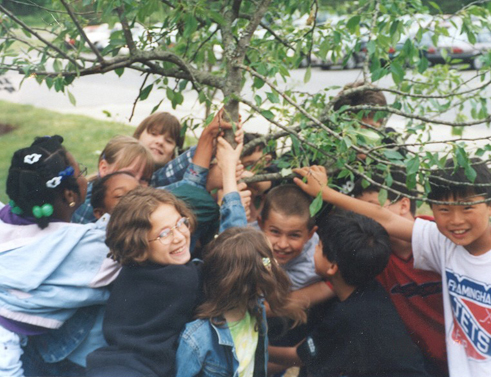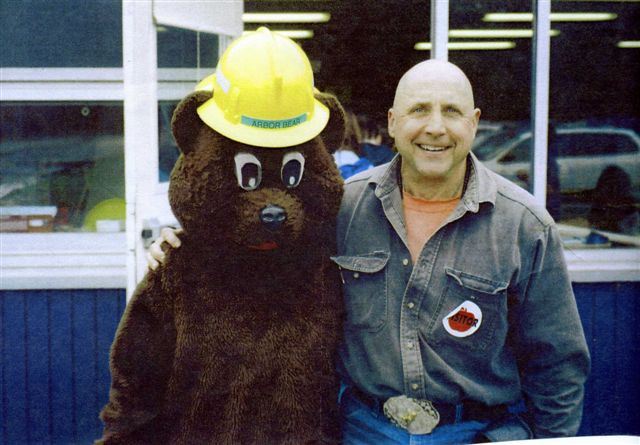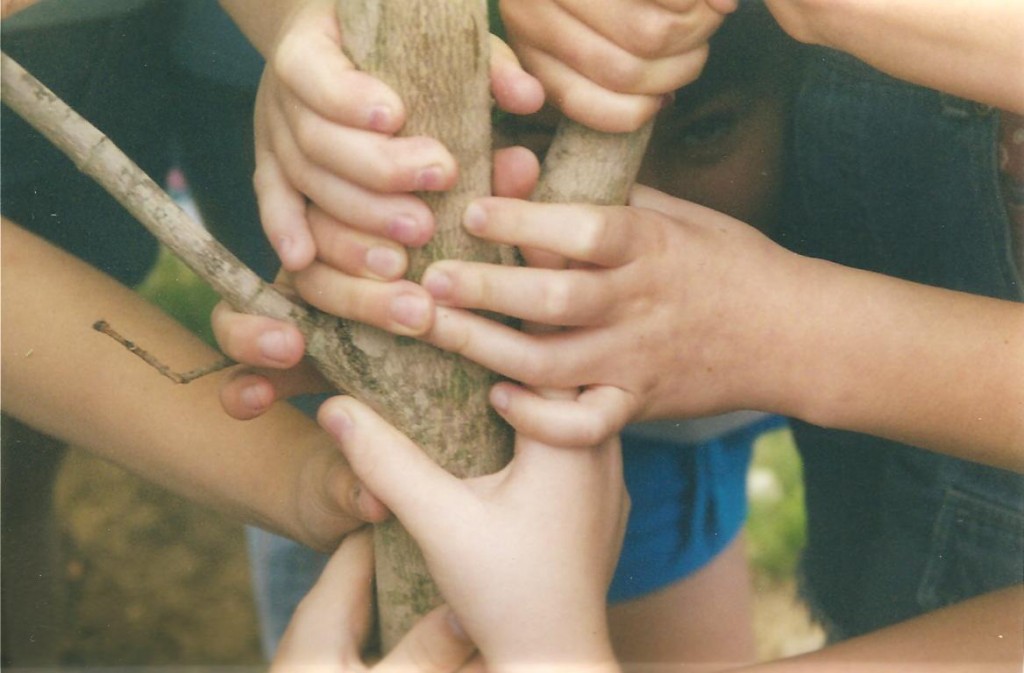Tree & Plant Education
trees can touch your “spirit”
Tree & Plant Education
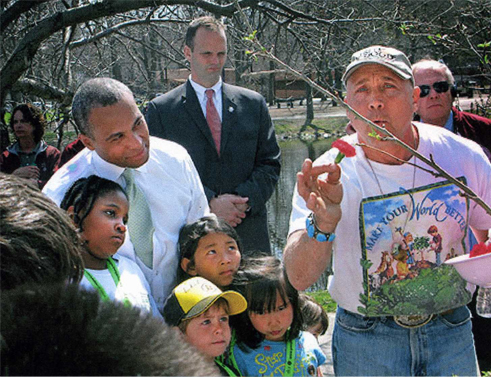 Earth Day Around the World
Earth Day Around the World
Joseph Kowalski (right), a tree biologist and arborist, told children today about the importance of connection – with people and nature. The kids and Governor Deval Patrick (left) helped plant a tree near the Hatch Shell in Boston.
(Photo courtesy of the Boston Globe)
TEACHING RESPECT – AND MORE – WITH TREES
Tree Care Industry Magazine – November 2005
How does someone plant a tree with Heart? The answer can be seen by the connections some Massachusetts third graders make in a program called “Touch Trees”.
Every spring for the past six years tree biologist Joseph Kowalski, of the Massachusetts Department of Conservation and Recreation, and Rachel Shea, a storyteller/librarian at Clark University in Worcester, Mass. present this educational program to third grade classrooms in the Wachusett Reservoir region in Central Massachusetts. This year the program was conducted in Holden, Mass.
Kowalski’s goal is for the pupils to develop a special relationship with the tree they plant to create a greater awareness of themselves and of the world they live in.
This is done by interspersing basic tree biology, a little self-reflection, Native American (Lakota) traditional teachings and a hands-on approach to learning that there might be more to planting a tree then one might think.
Kowalski asks the children to contemplate how their hopes and dreams can be realized if they foster them with sincerity, attention and care, similar to the attention and care a tree needs to grow.
According to Lakota tradition, the Sacred Hoop (Cankleska Wakan) is all about understanding the Circle of Life, how to be and live in a space of gratitude and the realization that giving is more important then receiving.
The “Touch Trees” program starts in the classroom with a discussion about the things(gifts) trees give to people, animals and the earth. These “gifts” range from those that you can touch, taste and smell to some of the more intangible but no less important gifts.
The discussion describes how trees can touch your “spirit” and have the unique ability to simply make you feel better being around, under or even in them. Trees give these things freely without ever asking for anything in return. It is a perfect example of how nature works at its best and how we should live our own life(s).
After these points are made, the discussion shifts to what the students can give to the tree they are about to plant so that the tree can continue the cycle and give back to them. The concept of giving is explained with the image of a circle or “hoop”. The lesson explains that giving returns to the giver in the same way that a circle or “hoop” returns upon itself.
The teachings explain that when one gives to a tree, a person or a community(their classmates), one never really loses anything but gains back many things in return, often something one was unaware of at the time of giving.
In addition to the obvious needs of providing sufficient space, soil and water, another important things that the students can give to the tree is honor and respect. This shows how the tree lives as an active part of this Circle of Life and that sometimes the things you can’t hold or see have the most value.
Giving kindness, politeness, courtesy or even a listening ear to your classmates, brothers and sisters and friends is a very valuable activity in and of itself, and is as much a part of the flow of nature as a tree giving leaves back to the earth in the fall. The concept of being virtuous is brought forth in a tangible way to the students’ young minds. “Living in a good way” – as a Lakota elder might speak.
Rachel Shea supplements this theme through the narration of a story. She explains the “Joe relates the basics of tree biology and the intellectual aspects of the giving tree and then the story I relate takes the same message into their Hearts”
Before the class goes out to the school yard to plant the tree, Kowalski establishes the “special” relationship between the tree and the students. Kowalski asks each student to choose a wish that is important to them and write it on a colored piece of paper that is shaped like a leaf. It should be a wish they choose to manifest in their lives.
“This is not a little wish like a trip to McDonalds after school or a birthday present”, Kowalski explains, “but a big wish, such as “I want to be an astronaut or teacher” or “I want to be more kind and generous toward my family and friends”
When the wishes are completed, they are collected by a designated “wish collector” in a special “wish bag.”
After the classroom portion of the program, the children follow Kowalski and Shea out to the school yard, where a tree stands in the prepared planting site. Four 12-foot sugar maples were planted at the school this year, one by and for each third-grade classroom. The four form a leafy line at the front of the school.
The students are given the opportunity to touch the roots and soil and to gain an appreciation for the below ground landscape of a tree. Before the class helps add soil with student-sized shovels, the paper wish leaves are sprinkled around the root ball within the planting site.
That special relationship is now beginning with their wish-bearing tree. The hope is that when the children check back with “their” tree in the coming years, they will not only check in on its height, health and vitality but will also remember the wishes they planted with it, and they will have the opportunity to ask themselves, “Am I doing the things that I said I would in order to fulfill my wish?”
After the soil is added to the planting site the students water the newly planted tree from a fire hose provided by the local fire department.
Last but not least, the students honor the tree with a respectful group hug that send it a collective silent blessing. There is nothing quite like lots of little hands and even bigger smiles to get the newly planted tree off to a good start.
Below left, Holden, Massachusetts elementary school students embrace one of the trees they planted. Below right, a student adds her paper leaf wish to the planting.
(Images provided by Tree Care Industry – November 2005)
Cultivating Dreams – Wish Bearing Tree Planted
Sterling – Joseph Kowalski wants pupils to develop a relationship with the trees he has them plant as part of his school programs.
It’s done by having the children think about how their own goals and wishes can only grow if they foster them with diligence, attention and care–the same things a tree needs to grow.
Small pieces of paper were passed out to each pupil in teacher Yola Beliveau’s third grade class at the Florence G. Houghton Elementary School on Tuesday, where Mr. Kowalski conducted his 90 minute tree program for five classes Tuesday and Wedsnesday.
Mr. Kowalski, a tree biologist with the Metropolitan District Commission in West Boylston, asked the children to write down a wish, something special they hoped to be or do someday when they were grown up. The pieces of paper would be collected and placed under the roots of the tree awaiting planting outside on the school grounds.
Mr. Kowalski told them to make it a really big wish, one that could grow along with them–and the tree.
Jonathan Latino’s hand shot into the air, “Should we write our name on it so the tree will know whose wish it is?’ he asked.
“It will know”, Mr. Kowalski assured him.
Storyteller Rachel shea worked with Mr. Kowalski, supplementing his message through the narrative form. After Mr. Kowalski talked about plant biology and the nuts and bolts of keeping a tree alive. Ms. Shea offered a story on the “if we take care of them, they will take care of us” theme.
“Stories reach the inner core” she said. Mr. Kowalski “talks about the intellectual aspects of it, and then the story takes it into their hearts.
And hands.
After the classroom basics, the children followed Mr. Kowalski and Ms. Shea out to the schoolyard, where a 12 foot tall sugar maple stood positioned within a hole at its planting site. It was the first of five such trees to be planted, one for each class participating in the program.
The other trees, their roots tied securely in burlap, waited beside their respective holes, forming a leafy line at the front of the school. They will replace five other trees removed after suffering severe damage in a recent drought.
The children greeted the tree warmly. “Hi tree” “I love you, tree!” were common greetings. There were others. “Can I carve my name in it?” asked one boy, who apparently had not yet absorbed the “treat trees as you would be treated” lesson he had heard in the classroom.
Shovels were provided to give each pupil the chance to add some soil to the planting hole. But the most fun occurred when it was time to pass the hose around to give each child a chance at watering the tree.
“Let’s squirt the girls!” a boy said, to a chorus of squeals from his female classmates. Ms. Shea gently intervened. “It’s the tree that needs the water”, she said.
Mr. Kowalski and Ms. Shea said they want the pupils to develop a special relationship with the wish bearing trees they plant. The hope is that, when the children check back in with “their” tree in the coming years, they will not only check in on its height, health and condition, but also be reminded of the wishes they planted with it.
“We’re trying to get them to develop that special relationship with the tree.” Mr. Kowalski said. “The biggest thing we can give back to the tree is not something that they can hold, like soil or water. It’s respect and honor.
Houghton Elementary School principal Anthony M. Cipro Jr. said he feels the program echoes the five values he tries to stress to pupils. Honesty, cooperation, responsibility, respect and kindness.
Those values are on display in all of the classrooms and the school office, and they are used in lessons as the “word of the week” for the first five weeks of school. The values help give a larger vision to a school experience often tightly wrapped in regulation by state curriculum mandates.
“We try to get away from teaching the rules and teach the ethics, the foundation of the rules”, Mr. Cipro said. “We must teach that we apply them, first and foremost, to out peer groups and adults, and then also to things such as trees.”
There is a curriculum connection, as well. In science, children study plants and habitats, and there is also a butterfly garden on the school grounds.
“We’re looking to incorporate environmental education with our academic subjects”, Mr. Cipro said “using the grounds and the tree plantings–especially in front of the school–is important because that’s where the kids get on and off the buses so they’ll see their own tree”
The kids agreed.
“I think it was a good thing especially putting all those wishes in there. That was a lot of fun” Jonathan said.
But can a tree help make a wish come true?
“I think it can because,ummmm actually I really don’t know” he said
His classmate, Samantha Cote, knows it was a good thing nevertheless.



